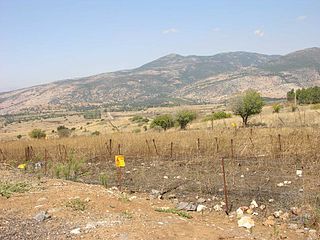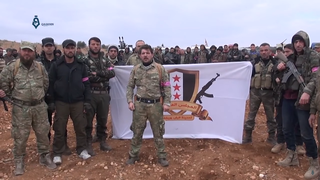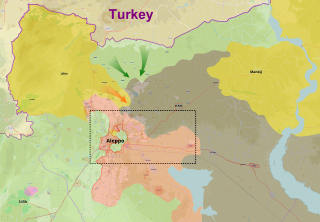
The 2000–2006 Shebaa Farms conflict was a low-level border conflict between Israel and Hezbollah for control of Shebaa Farms, a disputed territory located on the Golan Heights–Lebanon border. Fighting between the two sides primarily consisted of Hezbollah rocket and mortar attacks on Israel and Israeli artillery barrages and airstrikes on Hezbollah in southern Lebanon. Clashes began a few months after the 2000 Israeli withdrawal from Lebanon, which Hezbollah viewed as incomplete due to the presence of the Israel Defense Forces in Shebaa Farms. The conflict culminated in the 2006 Lebanon War; Israel retains control over the territory.
As the civil uprising phase of the Syrian Civil War turned into an all-out civil war, the 911-kilometre-long (600 mi) Syria–Turkey border became the scene of minor military clashes between the Turkish Army and various factions in the war to the south.

Beginning in December 2012, Sunnis in Iraq protested against the Maliki government. On 28 December 2013, a Sunni MP named Ahmed al-Alwani was arrested in a raid on his home in Ramadi. Alwani was a prominent supporter of the anti-government protests. This incident led to violence in Al Anbar Governorate between the Iraqi Army and a loose alliance of tribal militias and other groups fighting alongside the Islamic State of Iraq and the Levant (ISIL).

The spillover of the Syrian Civil War is the impact of the Syrian Civil War in the Arab world and beyond. Since the first protests during the Arab Spring, the increasingly violent Syrian Civil War has been both a proxy war for the major Middle Eastern powers, Turkey and Iran, and a potential launching point for a wider regional war. Fears of the latter were realized when the Islamic State of Iraq and the Levant (ISIL), a Salafi Jihadist militant group and alleged former al-Qaeda affiliate, established itself in Syria in 2013, and later combined with the War in Iraq (2013–2017) into a single conflict the following year. The spillover of the Syrian Civil War is often dubbed the Arab Winter.
The following is a timeline of the Syrian civil war from August to December 2014. Information about aggregated casualty counts is found at Casualties of the Syrian Civil War.

Turkey's involvement in the Syrian civil war began diplomatically and later escalated militarily. Initially, Turkey condemned the Syrian government at the outbreak of civil unrest in Syria during the spring of 2011; the Turkish government's involvement gradually evolved into military assistance for the Free Syrian Army in July 2011, border clashes in 2012, and direct military interventions in 2016–17, in 2018, in 2019, 2020, and in 2022. The military operations have resulted in the Turkish occupation of northern Syria since August 2016.

The Timeline of the War in Iraq covers the War in Iraq, a war which erupted that lasted in Iraq from 2013 to 2017, during the first year of armed conflict.

The IS-related terrorist attacks in Turkey refers to a series of attacks and clashes between Turkey and the Islamic State (IS) as part of the spillover of the Syrian Civil War. Turkey joined the international military intervention against the Islamic State in 2016, after ISIL attacks in Turkey. The Turkish Armed Forces' Operation Euphrates Shield was partly aimed at IS, and part of the Turkish occupation of northern Syria, around Jarabulus and al-Bab, was conquered from IS.
The following is a timeline of the Syrian Civil War from January to July 2015. Information about aggregated casualty counts is found at Casualties of the Syrian Civil War.
In late July 2015, the third phase of the Kurdish–Turkish conflict between various Kurdish insurgent groups and the Turkish government erupted, following a failed two and a half year-long peace process aimed at resolving the long-running conflict.
This article contains a timeline of events from January 2015 to December 2015 related to the Islamic State of Iraq and the Levant (ISIL/ISIS). This article contains information about events committed by or on behalf of the Islamic State, as well as events performed by groups who oppose them.
The following is a timeline of the Syrian Civil War from May to August 2016. Information about aggregated casualty counts is found at Casualties of the Syrian Civil War.

Operation Euphrates Shield was a cross-border military operation conducted by the Turkish Armed Forces in the Syrian Civil War which led to the Turkish occupation of northern Syria. Operations were carried out in the region between the Euphrates river to the east and the rebel-held area around Azaz to the west. The Turkish military and Turkey-aligned Syrian rebel groups, some of which used the Free Syrian Army label, fought against the forces of the Islamic State (IS) as well as against the Syrian Democratic Forces (SDF) from 24 August 2016. On 29 March 2017, the Turkish military officially announced that Operation Euphrates Shield was "successfully completed".

The northern al-Bab offensive was a military offensive and part of the third phase of Operation Euphrates Shield launched by the Turkish Armed Forces and factions from the Free Syrian Army and allied groups, with the goal of capturing the city of al-Bab located north of Aleppo from the Islamic State of Iraq and the Levant.
The following is a timeline of the Syrian civil war for 2021. Information about aggregated casualty counts is found at Casualties of the Syrian civil war.
The following is a timeline of the Syrian civil war for 2022. Information about aggregated casualty counts is found in Casualties of the Syrian civil war.






